I had the opportunity (and unique honor) to teach a MOOC (Massive Open Online Course) on Web Design recently. [Actually, the course is still in progress as final assignments are due on Nov. 2, 2014.] I wanted to share some observations and insights about the process as well as the technology. There will be a series of posts covering my experiences. In this first post, I wanted to share what the actual course looked like. But, before getting started, I want to offer my thanks and appreciation to my colleagues Greg Hodgson (@greghodgson) [London vicinity] and Jason Carthew (@jasoncarthew) [Sydney vicinity] for their help and collaboration. Their help made it so much easier to offer this class. In this blog post, I wanted to provide a short overview of the class and cover a bit of the technology. We had a total of 659 individuals take the class. They were distributed in many parts of the world (with a large percentage in North America). I have included a map. We asked everyone to drop a pin where they were located. You can click on the image to see a larger version.
Because of the worldwide distribution of participants, we offered live sessions in both US (Chicago time) and Australia (Sydney time) at 7 p.m. Many thanks to Jason for handling the Australian version. We decided to use a bootcamp format to try and keep everyone engaged. As many readers know, the completion rates for MOOCs are low. We met every night for a week, then took a break and met one final time. All meetings used Adobe Connect (and all sessions were recorded). Those who could not attend in person often commented they found the recordings very valuable. Because the class is presently in progress, I can’t provide an overview of the completion rate. That will be the subject of another post.
We used the Adobe Education Exchange as the venue for the class. The course was publicized by Adobe. The Education Exchange is a fantastic place for finding resources on a variety of technology topics (with an obvious focus on Adobe products). Throughout the duration of the live sessions, this course was featured in the professional development part of the main Education exchange page.
When one registered for the course, one received immediate access to all the course materials. You could work at your own pace. Progress is tracked and you do need to complete periodic assignments. This is what a part of the course looked like while a person was taking it. I just scrolled down a bit on the initial page so you can see the general format. Note that one clearly sees what has been accomplished and what remains.
When you click on a link, you would be presented with details for that module. In the example below, there is an embedded video (from my Vimeo channel) and some introductory text. You can also clearly see the progress in the section.
Again, you can always click on any image to enlarge it. Each segment is divided into a specific task. Homework assignments were required for each day. Details of the homework assignment area is shown below.
Each participant needed to also review the work of at least 3 others and needed to rate their work (on a scale of 1 to 5). This is a requirement of the Education Exchange in order for those completing the course to receive their certificate and badge.
We used the Twitter hashtag #AdobeGenPro throughout the course. This allowed us to track comments and provided another means of communication beyond the course itself.
That is a quick overview of the course itself. In another post, I plan to focus on the preparation and technologies involved. I also hope to report on completion rates and more.
As always, I am interested in your feedback. Have you ever taken a MOOC? Did you take this one? What was your experience like?
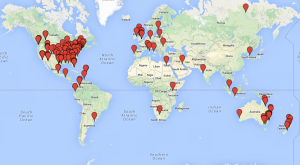
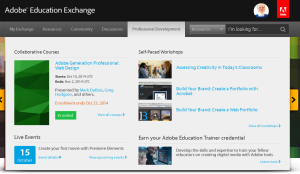
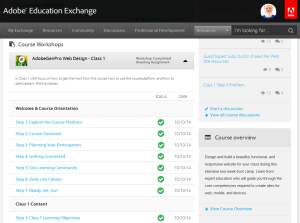
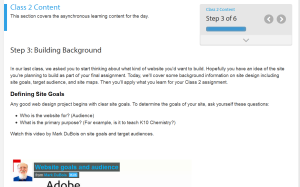
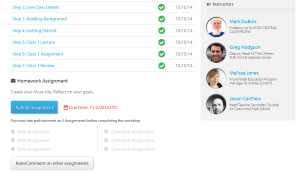


Mark,
You obviously belong at a bigger school. ISU is supposedly revamping their whole web program there, adding more classes around web development than before and possibly making it into a separate major instead of just a sequence in Info. Systems. I could connect you with someone high in the school of IT if interested.
Hi Kevin:
Many thanks for your kind words. I appreciate the offer. In the short term, I will probably stay a while longer at my present school. It is nice to be a fully tenured professor.
Best always,
Mark